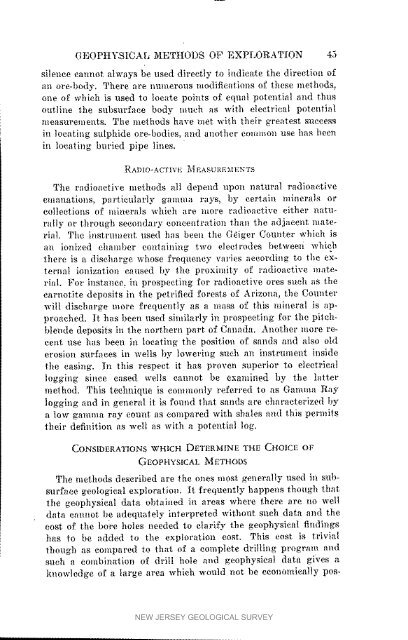Bulletin 54. Geophysical Methods of Exploration and their ...
Bulletin 54. Geophysical Methods of Exploration and their ...
Bulletin 54. Geophysical Methods of Exploration and their ...
Create successful ePaper yourself
Turn your PDF publications into a flip-book with our unique Google optimized e-Paper software.
GEOPHY_qICAL METHODS OF EXPLORATION 45<br />
silence emmot always be used directly to indicate the direction <strong>of</strong><br />
an ore-body. There are numerous modifications <strong>of</strong> these methods,<br />
one <strong>of</strong> which is used to locate points <strong>of</strong> equal potential <strong>and</strong> thus<br />
outline the subsurface body much as with electrical potential<br />
measurements. The methods have met with <strong>their</strong> greatest success<br />
in locating sulphide ore-bodies, al_d another common use has been<br />
in locating buried pipe lines.<br />
RADIO-ACTIVE<br />
MEASUREMENTS<br />
The radioactive methods all depend upon natural radioactive<br />
emanations, particularly gamma rays, by eertaiu minerals or<br />
collections <strong>of</strong> minerals which are more radioactive either naturally<br />
or through secondary concentration than the adjacent material.<br />
The instrument used has been the G4iger Counter which is<br />
an ionized chamber eoutainiag two electrodes between which<br />
there is a discharge whose frequency wuqes according to the external<br />
ionization caused by the proximity <strong>of</strong> radioactive materiM.<br />
For instance, in prospecting for radioactive ores such as the<br />
earnotite deposits in the petrified forests <strong>of</strong> Arizona, the Counter<br />
will diseharge more frequently as a mass <strong>of</strong> this mineral is approached,<br />
It has been used similarly in prospecting for the pitchblende<br />
deposits in the northern part o£ Canada. Another more recent<br />
use has been in locating the position <strong>of</strong> s<strong>and</strong>s <strong>and</strong> also old<br />
erosion surfaces in wells by lowering such an instrument inside<br />
the easing. In this respect it has proven superior to electrical<br />
logging since cased wells cannot be exanfined by the latter<br />
method. This technique is commonly referred to as Gannna Ray<br />
logging <strong>and</strong> in general it is found that s<strong>and</strong>s are characterized by<br />
a tow gamma ray count as compared with shales <strong>and</strong> this permits<br />
<strong>their</strong> definition as well as with a potential log'.<br />
CONSIDERATIONS WHICH DETERMINE ]'HE CHOICE OF<br />
GEOPHYSICAL<br />
METHODS<br />
The methods described are the ones most generally used in subsurface<br />
geological exploration. It, frequently happens though that<br />
the geophysical data obtained in areas where there are no well<br />
data cannot be adequately interpreted without such data <strong>and</strong> the<br />
cost <strong>of</strong> the bm'e holes needed to clarify the geophysical findings<br />
has to be added to the exploration cost. This cost is trivial<br />
though as compared to that <strong>of</strong> a complete drilling program <strong>and</strong><br />
such a combination <strong>of</strong> drill hole <strong>and</strong> geophysical data gives a<br />
knowledge <strong>of</strong> a large area which would not be economically pos-<br />
NEW JERSEY GEOLOGICAL SURVEY

















